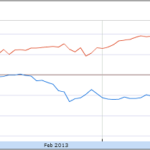Precious Metals ETFs may play an important role in this environment. After years of a slowly deteriorating US dollar, the greenback found some footing during the financial crisis and is now benefiting from the financial woes in Greece which may well boil over into other Euro-zone countries. However, this near term calamity doesn’t address the underlying fundamental problems with US currency stability, especially against rapidly growing and lower leveraged emerging markets. With the US dollar likely to continue to lose buying power in terms of global currencies in the coming years, investors have a few tools at their disposal to exploit this secular trend.
First, there are multiple currency ETFs which focus on either an individual country or even a basket of countries that rise when the US dollar falls in parity. However, for those looking to both hedge a weaker dollar, hedge inflation AND benefit from the sporadic panic moves that occur when a Black Swan event occurs in the Us like a financial crisis or a terrorist attack, there are precious metals. Historically, investors had to take physical custody of gold, platinum, silver and other commodities, but now there are several ETFs that make physical custody a thing of the past. Evidently, investors are eager given that we saw commodity ETF inflows more than double in 2009.
Platinum ETF Summary:
Issuing Company: ETF Securities Ltd
Ticker: PPLT
Expense Ratio: 0.60%
YTD Return: 1.0%
*launched mid-Jan
Palladium ETF Summary:
Issuing Company: ETF Securities Ltd
Ticker: PALL
Expense Ratio: 0.60%
YTD Return: 7.4%
*launched mid-Jan
Silver ETF Summary:
Issuing Company: iShares
Ticker: SLV
Expense Ratio: 0.5%
YTD Return: 1.0%
Gold ETF (physical) Summary:
Issuing Company: SPDR
Ticker: GLD
Expense Ratio: 0.4%
YTD Return: 0.6%
Gold ETF (mining and exploration) Summary:
Issuing Company: Market Vectors
Ticker: GDX
Expense Ratio: 0.55%
YTD Return: -2.5%
Gold ETF (Gold Juniors Miners) Summary:
Issuing Company: Market Vectors
Ticker: GDXJ
Expense Ratio: 0.6%
YTD Return: -0.2%
Tax Treatment of Precious Metals ETFs:
You’ll see this or similar language in the prospectus of many metals ETFs: Under current law, gains recognized by individuals from the sale of ‘collectibles,’ including physical platinum, held for more than one year are taxed at a maximum federal income tax rate of 28%, rather than the 15% rate applicable to most other long-term capital gains.
It comes down to whether the ETF has physical custody of the metal or whether it’s a portfolio of companies in the metals and mining business. With this in mind, you’d need to think about say, GLD vs. GDX and which one makes sense for you. Is one held in a tax-advantaged account? Are you looking to avoid the operational aspect of gold companies themselves? How long do you plan on holding? By factoring in some of these differences and the tax rate difference, at least you’ll be educated since on a large gain, the impact of the spread in tax treatment will appear to be rather large.
Will the Trend Continue?
When viewing a list of ETFs Up Over 100% in 2009, commodities and metals ETFs were very well represented. Whether we’ll see a repeat in 2010 remains to be seen, but given the lower correlation to other traditional assets and inflation protection, there’s something to be said for reserving a spot in your portfolio of one or more of these ETFs.
Note that there are also leveraged ETFs for these commodities but these are very poor “investments”, and really only worth of a near term trade. They are so poor in fact, that I’ve been routinely employing a two-way short leveraged ETF strategy (I’m shorting both the long and short Gold ETFs simultaneously which is working out quite nicely).
Disclosure: Author is long GDXJ with no other holdings mentioned in the summary profiles.










{ 0 comments… add one now }